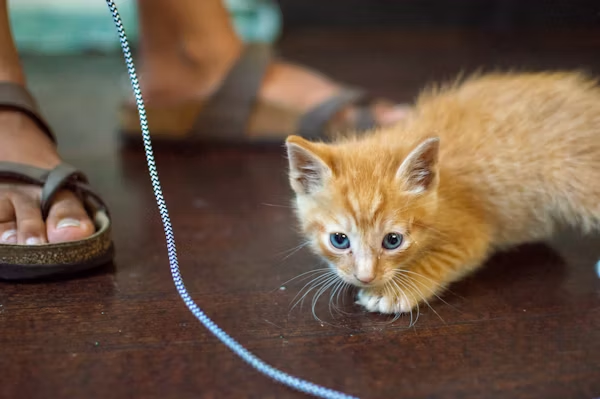Introduction
Cats are known for their agility, curiosity, and love of high places. If you’ve ever seen a cat perched on top of a bookshelf or climbing up a tree, you’ve witnessed their natural instincts at work. But why do cats love to climb so much? And how can you provide safe climbing options for your feline friend? In this blog post, we’ll explore the reasons behind this behavior and offer practical tips for creating a safe and enriching environment that satisfies your cat’s need to climb.
Why Do Cats Love to Climb?
1. Instinctual Behavior
Cats are natural predators, and in the wild, they climb to hunt and to escape from larger predators. Climbing gives them a vantage point from which they can observe their surroundings, scout for prey, and stay safe. This instinctual behavior is deeply ingrained, even in domesticated cats.
2. Curiosity and Exploration
Cats are curious creatures, and climbing allows them to explore their environment. From a high perch, a cat can see more of its territory, which satisfies its curiosity and provides mental stimulation. This exploration is essential for keeping a cat’s mind active and engaged.
3. Territorial Instinct
Cats are territorial animals, and they often claim spaces as their own. Climbing allows them to establish and control territory by occupying high places. This behavior helps them feel secure and in control of their environment, reducing stress and anxiety.
4. Exercise and Physical Health
Climbing is a great form of exercise for cats. It helps them build and maintain muscle tone, improves balance, and keeps their joints flexible. Regular climbing activities can also prevent obesity, which is a common issue in indoor cats.
5. Comfort and Security
High places offer a sense of safety and comfort to cats. A cat may retreat to a high perch to relax, sleep, or simply observe its surroundings without being disturbed. This behavior is particularly common in multi-pet households, where a cat may need a safe space away from other animals.
How to Provide Safe Climbing Options
1. Cat Trees and Towers
Cat trees are a popular choice for providing safe climbing options indoors. These structures often include multiple levels, scratching posts, and cozy nooks for resting. When choosing a cat tree, consider the following:
- Height: Ensure the cat tree is tall enough to satisfy your cat’s climbing instincts, but not so tall that it becomes unstable.
- Stability: The base should be sturdy to prevent tipping over, especially if you have a large or energetic cat.
- Materials: Look for materials that are durable and safe for your cat to scratch and climb on. Sisal and carpeted surfaces are common and effective choices.
2. Wall-Mounted Shelves
Wall-mounted shelves offer a space-saving solution for cats who love to climb. These shelves can be arranged in a way that creates a vertical playground for your cat. To ensure safety:
- Installation: Securely anchor the shelves to the wall to support your cat’s weight.
- Spacing: Place the shelves at intervals that are easy for your cat to jump between, considering their age and agility.
- Comfort: Add non-slip mats or cushions to the shelves to provide comfort and prevent slipping.
3. Window Perches
Window perches allow cats to combine their love of climbing with their love of watching the outside world. These perches are often attached to windowsills and provide a comfortable spot for your cat to lounge and observe. Consider the following:
- Weight Capacity: Ensure the perch can support your cat’s weight.
- Sunlight: Place the perch where your cat can enjoy natural sunlight, which provides warmth and additional stimulation.
- Safety: Make sure the perch is securely attached and won’t detach under your cat’s weight.
4. Cat Condos and Tunnels
Cat condos and tunnels provide enclosed spaces that appeal to a cat’s natural instincts to hide and climb. These structures can be used as part of a larger climbing setup or as standalone pieces. When selecting a cat condo:
- Size: Choose a size appropriate for your cat, ensuring they have enough space to move around comfortably.
- Entry Points: Multiple entry points allow your cat to enter and exit the condo easily, making it more engaging.
- Materials: Look for durable materials that can withstand scratching and climbing.
5. Outdoor Enclosures (Catio)
For cats that enjoy the outdoors, a catio (cat patio) provides a safe environment where they can climb, explore, and enjoy fresh air. A well-designed catio can include ramps, shelves, and climbing structures. Key considerations include:
- Safety: Ensure the enclosure is escape-proof and protects your cat from potential dangers like predators or traffic.
- Weather: Provide shelter within the catio so your cat can take cover from rain or excessive sun.
- Enrichment: Include various elements like climbing poles, perches, and toys to keep your cat entertained.
6. Interactive Play and Toys
Interactive toys that encourage climbing and jumping can also be beneficial. Toys like laser pointers, feather wands, and motorized mice can stimulate your cat’s hunting instincts, encouraging them to climb and leap. Ensure that playtime is safe by:
- Supervision: Always supervise playtime with interactive toys to prevent injury.
- Safe Materials: Choose toys made from non-toxic materials that won’t break easily.
Tips for Encouraging Safe Climbing Behavior
1. Positive Reinforcement
Encourage your cat to use designated climbing structures by using positive reinforcement. Offer treats, praise, or affection when your cat climbs the cat tree or uses the wall-mounted shelves. This will help them associate these areas with positive experiences.
2. Avoiding Hazardous Areas
Prevent your cat from climbing in unsafe areas, such as kitchen counters or high cabinets. You can do this by:
- Blocking Access: Use barriers or deterrents like double-sided tape or aluminum foil to make these areas less appealing.
- Providing Alternatives: Make sure your cat has access to safe climbing options that are more attractive than the restricted areas.
3. Regular Maintenance
Regularly check your cat’s climbing structures for signs of wear and tear. Tighten any loose screws, replace worn-out scratching posts, and clean the surfaces to ensure your cat’s safety.
4. Customizing to Your Cat’s Preferences
Observe your cat’s behavior to determine their climbing preferences. Some cats may prefer tall, narrow spaces, while others might enjoy wide, flat perches. Customize your setup to match your cat’s unique needs and preferences.
Conclusion
Climbing is a natural and essential behavior for cats that contributes to their physical health, mental stimulation, and emotional well-being. By providing safe and engaging climbing options, you can create an environment that satisfies your cat’s instincts and enhances their quality of life. Whether it’s a tall cat tree, wall-mounted shelves, or an outdoor catio, these options will keep your feline friend happy, healthy, and entertained.
This blog post provides a comprehensive look at why cats love to climb and how to ensure they have safe climbing opportunities in your home. By understanding and catering to this natural behavior, you can help your cat lead a fulfilling and contented life.











Leave a Reply